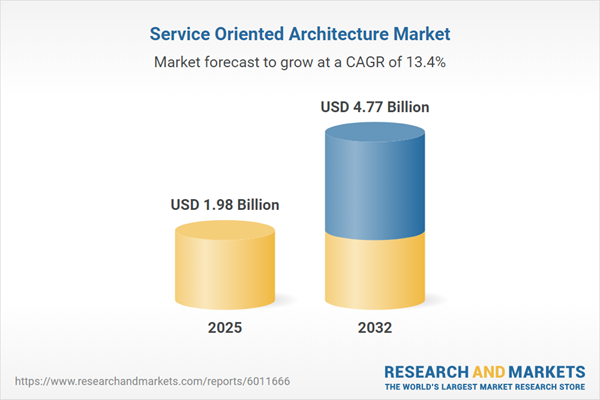Speak directly to the analyst to clarify any post sales queries you may have.
The service oriented architecture market is redefining how enterprises modernize IT infrastructure, enhance operational agility, and align with evolving digital and regulatory demands. Senior decision-makers increasingly turn to SOA to enable seamless modernization, unified processes, and adaptive capacity in complex organizational settings.
Market Snapshot: Service Oriented Architecture Market Outlook
The service oriented architecture (SOA) market is steadily advancing as organizations intensify digital transformation efforts and move away from legacy technology. Backed by robust executive commitment, the adoption of SOA enables enterprises to develop integrated, flexible technology landscapes that standardize processes and improve workflow continuity. The market benefits from growing interest in architectures designed for seamless interoperability, helping businesses manage increasingly intricate operations. SOA’s scalable frameworks address emerging operational requirements and allow enterprises to remain resilient in a continuously shifting business environment.
Scope & Segmentation of the SOA Market
This report details the defining segments, technologies, and regional trends that shape SOA adoption and directly influence enterprise architecture strategies:
- Components: Integration platforms, orchestration layers, and management tools reinforce application consistency and operational dependability across distributed business environments.
- Deployment Modes: Public, private, hybrid cloud, and on-premises SOA models accommodate different compliance, security, and scalability requirements, allowing organizations to align technology with internal policies.
- Organization Size: Enterprises of all scales leverage SOA, tailoring their infrastructure to suit project scope, resource availability, and workflow complexity.
- Service Types: Microservices, RESTful APIs, and SOAP-based services foster modular development, supporting rapid integration and time-to-market for new digital solutions.
- Governance Approaches: Consistent frameworks—including standardized protocols and process oversight—ensure regulatory alignment and efficient decision-making across deployments.
- Security Measures: Advanced tools and standards, such as OAuth, SAML, TLS, and centralized identity management, defend integrated systems against evolving cyber threats.
- Industries: Key sectors—banking, government, telecommunications, healthcare, manufacturing, and retail—advance SOA adoption to bolster regulatory compliance and streamline mission-critical processes.
- Regions: Patterns of SOA implementation diverge by geography, with North America, Latin America, Europe, the Middle East and Africa, and Asia-Pacific refining approaches based on regulatory frameworks and investment dynamics.
- Key Players: Influential vendors such as IBM, Oracle, Microsoft, Software AG, TIBCO Software, SAP, MuleSoft, Red Hat, Dell Boomi, and WSO2 drive technology advancement and establish industry benchmarks.
Key Takeaways for Senior Decision-Makers
- Adopting SOA equips organizations with the ability to recalibrate IT foundations in step with new business priorities and shifting compliance landscapes, ensuring ongoing progress in transformation goals.
- Modular deployment options enhance adaptability, giving IT leaders the flexibility to modernize efficiently across diverse operational scenarios.
- The integration of microservices and container-based strategies accelerates application rollouts and empowers organizations to anticipate or respond quickly to change.
- Structured governance and comprehensive security protocols minimize compliance exposure, providing a foundation for secure and consistent operations across borders.
- Technology adoption in high-compliance sectors like finance and manufacturing secures vital data and processes, reinforcing workflow consistency and regulatory alignment.
- Accounting for local compliance needs, especially in multi-national contexts, enables organizations to sustain business continuity and adapt proactively to differing regional standards.
Impact of 2025 United States Tariffs
Forthcoming tariffs in 2025 are prompting enterprises in the United States to adjust technology investment strategies and decrease reliance on physical assets. SOA-based models offer greater adaptability and cost management, supporting more predictable budgets even as regulatory requirements become more complex. This is particularly relevant for small and midsize organizations seeking operational resilience amid fluctuating policy conditions.
Methodology & Data Sources
This analysis draws on a comprehensive mix of secondary research, regulatory reviews, and targeted executive interviews. All findings are rigorously cross-verified to provide actionable insights that inform enterprise planning and effective leadership decisions.
Why This Report Matters
- Enables benchmarking of modernization initiatives, aiding leaders in aligning with industry best practices and prioritizing impactful technology investments.
- Delivers clear, strategic guidance on SOA governance, security, and region-specific compliance to help navigate the evolving digital and regulatory landscape.
- Supports organizational adaptability and risk preparedness through timely insights for navigating rapid business and regulatory shifts.
Conclusion
Service oriented architecture continues to shape enterprise modernization and operational efficiency. This report provides actionable intelligence to help senior leaders manage digital opportunities and adapt to regulatory change effectively.
Additional Product Information:
- Purchase of this report includes 1 year online access with quarterly updates.
- This report can be updated on request. Please contact our Customer Experience team using the Ask a Question widget on our website.
Table of Contents
3. Executive Summary
4. Market Overview
7. Cumulative Impact of Artificial Intelligence 2025
Companies Mentioned
The companies profiled in this Service Oriented Architecture market report include:- International Business Machines Corporation
- Oracle Corporation
- Microsoft Corporation
- Software AG
- TIBCO Software Inc.
- SAP SE
- MuleSoft, Inc.
- Red Hat, Inc.
- Dell Boomi, Inc.
- WSO2, Inc.
Table Information
| Report Attribute | Details |
|---|---|
| No. of Pages | 198 |
| Published | October 2025 |
| Forecast Period | 2025 - 2032 |
| Estimated Market Value ( USD | $ 1.98 Billion |
| Forecasted Market Value ( USD | $ 4.77 Billion |
| Compound Annual Growth Rate | 13.3% |
| Regions Covered | Global |
| No. of Companies Mentioned | 11 |









